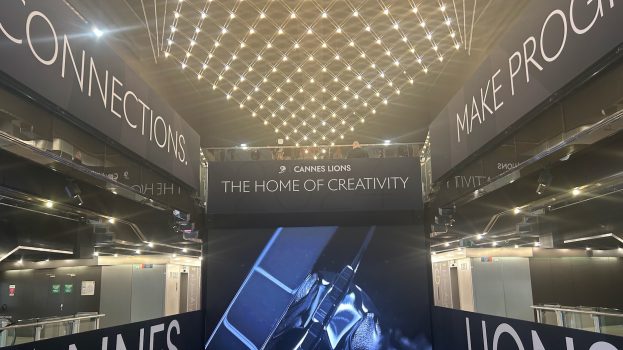It’s the year of the horse, according to the Chinese calendar. And you might think it’s also the year of the horse according to advertisers, given the steady stream of colts that have been trotted out in recent months.
There’s the horse that everyone’s favourite tree, StubHub and U.S. agency Duncan/Channon’s Ticket Oak was planning to ride on before he took a call on his bluetooth and agreed to hold tickets for a customer. Or the horse on which a woman goes galloping along the beach, as part of her over-the-top solo vacation away from her partner “Brian” in a Booking.com and Wieden+Kennedy Amsterdam commercial.
Or, here in Canada, the talking horse in Kraft Dinner’s latest, anthemic spot by Anomaly Toronto, that trots through the streets and urges business folks to loosen their ties a little and “Let your fun out.”
[iframe_youtube video=”vDycTUMsUcE”]
Horse-play aside, these ads all have a touch of zaniness to them, joining a steady parade of attention-grabbing ads that, even without an animal, seem to be channelling humour that is decidedly off-the-wall. Lately, being a bit wacky seems to be the calling card for creatives trying to break through to consumers inundated with messages, whether with a talking horse whose authority no one questions, a Source sales associate who appears, as if by magic, in a customer’s backyard, or a regular-looking Joe participating in sports – from luge and hockey to synchronized swimming and bodybuilding.
[iframe_youtube video=”Sf6dwj44__g”]
[iframe_youtube video=”9zG4671fhbQ”]
Peter Ignazi and Carlos Moreno, SVPs, ECDs at BBDO Toronto, the agency behind some kooky work for Skittles, say they have noticed an uptick in silliness in creative approaches. While the pair thinks it may be a cyclical trend, they note that in today’s marketplace brands are recognizing their work competes not just against their competitors in a segment, but all forms of entertainment, including comedy platforms like Funny or Die.
“There is so much more that people are paying attention to, where their brains are being called upon, so you need to really figure out how to break through,” Moreno says. “Once you put that lens on what you’re working on, you do have to look at the option of going a little absurd.”
And when brands and creatives get the humour right, the results are nothing to laugh at.
For instance, BBDO’s “Social Smoking” campaign, a Bronze Integrated Titanium winner at Cannes, was certainly hot, with its videos – which painted the occasional-smoking behaviour as ridiculous by comparing it to people farting at parties or swiping small bites of food from fellow restaurant-goers – generating more than two million views on YouTube in their first week and the overall campaign picking up 90 million impressions.
The agency’s “Touch the Rainbow” work for Wrigley Canada’s Skittles, including an online effort that urges users to interact with the clip by placing their fingers on computer screens to get involved in a bizarre scene, racked up more than nine million views and grew brand profit and market share by double digits.
“It can be very effective for your brand,” Ignazi says. “It breaks through and it gets shared and it gets a lot of PR. And earned media is a very important component nowadays.”
Jeff MacEachern, the CD at Taxi who worked on the Mio “Changes,” “Swish” and “Eye of the Squirter” ads, isn’t sure if there’s a trend, but he agrees that for the millennial target the Kraft brand was after, content that was a quirky and intentionally different was needed to break through.
“Your audience is already consuming that kind of content, actively searching for it and seeking it out, and the bar is pretty high out there,” he says. “They don’t have to watch commercials to get that. You do have to do something that is a little bit different, something that’s fresh.”
Fresh thinking delivered tasty results for Mio, which broke onto the Canadian market in 2012 with its 30-second spot featuring bizarre visual changes that had people hitting refresh on the videos, resulting in more than one million views on YouTube. Two follow-up ads got similar results and post-campaign tracking found that of people who recalled the ads, 75% linked it to the Mio brand.
Ignazi also theorizes that the emergence of more funny spots may be a sign that, following the economic downturn in 2008, people are looking to have some fun again and are more receptive to nutty ads.
Alan Madill, ECD at Juniper Park, says it’s possible marketers are feeling more confident about their brands now. But that doesn’t mean ads should be “wacky for the sake of being wacky.”
For his Toronto-based shop working on the “Backyard Monster Superstar” ad for The Source, the idea came from the brief, to communicate there is a Source store near every consumer. That’s demonstrated by a consumer’s backyard opening to reveal the inside of a Source store and the genie-like associate bearing Monster Superstar speakers. From there, the agency developed creative to grab people’s attention, from a neighbour in track pants and headband grooving in the backyard to a bird resting on the associate’s shoulder.
In a world where lots of research goes into creating TV commercials, ads start to feel similar and therefore aren’t getting people’s attention, Madill says. He believes while spots need to be on brand, the ones that walk a different walk tend to get noticed.
“There are so many commercials out there that are formulaic and bland,” Madill adds. “Our goal is to create interest.”
Franke Rodriguez, partner and president at Anomaly Toronto, also says letting a horse out of the barn was not a play for laughs but a vehicle to bring out the brand’s strategy of calling back to memories of being youthful and enjoying KD.
“KD is truly one of the few brands in the world that is a real cradle to the grave brand,” Rodriguez says. “We really wanted to harken back to that nostalgic memory of childhood and youth, of having a good time and letting your hair down.
“It was never a discussion of making it wacky,” he says, though he admits they did want to get people talking.
“How do we break through and resonate in a world where the everyday consumer is being bombarded by messages? That’s the challenge every brand talks about,” he says. “How do you actually break through? Every brand will use a different way… for us the message that makes sense is the idea of fun and youthfulness.”























